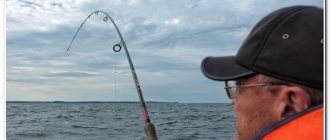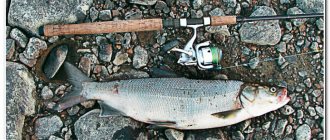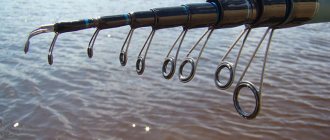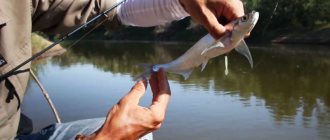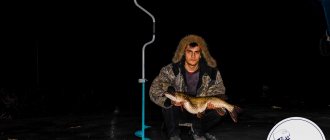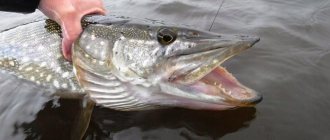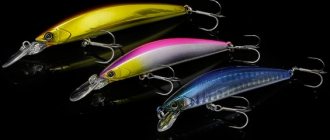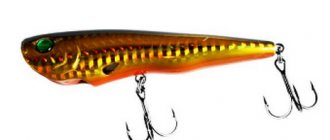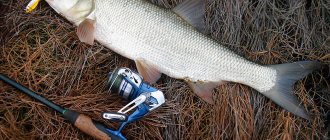There are main places where predators hunt for fry:
- A powerful stream of a river bed hitting or moving away from a bank.
- Pits or pools with snags and fallen trees are the favorite resting places for large ide.
- He goes hunting closer to the shore or in shallow water.
- On a lake or pond, it should be looked for on the edges between ditches and holes. If a hole or old channel runs between the islands, this place should be fished first.
The ide prefers a hard bottom than a muddy bottom.
Shallow water is a hunting ground for small ides. They sit in holes and wait for small fish to appear. But it will also react to small bait moving along the bottom. Even if you find a fishing spot where there are “fish”, you may be left without a catch, not knowing the right baits for this fish.
Technique for catching ide with a spinning rod
When fishing from the shore, it is better to examine the ide’s favorite hunting spots. When fishing in an unfamiliar body of water, you should look for holes and pools. Pay attention to the color of the water. In deep places the color will be darker. You can trawle the bottom with a fishing line and a sinker.
If you get into a hole, it will become a little harder to turn the reel and the line will weaken. This is how we determine the bottom topography. Having found out the places, we begin fishing. Different wiring should be used when changing types of spinners.
Catching ide in the summer from a boat is the main way of good fishing. At this time, the predator actively hunts small mounted fish. “Cauldrons” are formed. A flock of predators beats fish, huddled in one place.
Advice! When fishing for boilers, casting should be done along the edge of the school. In this way the fish are not scared away. With such a cast, the outermost individuals may be frightened, but the rest will be attracted by the play of the bait.
Where and when to fish
The behavior of ide, like the vast majority of other fish, depends on the time of year. It often happens that places where ide pecked well in the spring completely cease to please by summer. This happens due to changes in environmental conditions. It is necessary to consider where and at what time you can catch ide.
Spring
Ide differs from most other fish species in that spring is one of the most favorable periods for catching it. The fish begins to bite almost immediately after the ice breaks up, since even before the ice completely melts, it begins its pre-spawning glutton. At the same time, the most comfortable period, both in terms of fishing conditions and fish activity, is April.
At this time, it can be quite difficult to find a suitable place for fishing, since the melting of snow in the shortest possible time turns most of the coast into impassable mud, which is why you often have to search for promising points for a long time.
Catching ide with a spinning rod in the spring is mainly carried out in relative proximity to the shore: in the area of flooded bushes, trees fallen into the water and other natural or man-made shelters. On the river, fish at this time prefer to stay in places with weak currents, whirlpools and try not to go to channel streams. Wiring is used mainly with pauses, when, after passing near the bottom, the bait rises by several tens of centimeters, and then falls back.
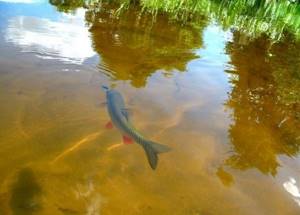
In the spring, you should pay attention to the transparency of the water and, if possible, choose places for fishing where the rise in level has not greatly affected its purity.
Summer
In the hot season, ide, like most other fish, experiences discomfort from rising temperatures and tries to move to deeper areas of the reservoir. At this time, relatively small specimens bite on the rifts, but it is better to look for larger fish at the border of the channel flow or directly in it, in the area where the depth drops off. In lakes, ide tries to choose the deepest areas. The ideal option would be if such places are also shaded. In summer, in small rivers, accumulations of ide can be found near a tree lying across the flow, behind which the fish hides from the flow and not far from similar shelters.
It is important to note that in some regions, ide is found near the coast and in relatively shallow places throughout June, especially if it was not too warm. However, already at the beginning of summer the bite worsens, the fish begins to be picky about baits and retrieves, which makes this period not the best for spinning anglers.
In summer, you can catch ide in most cases in the morning and evening. The exception is cloudy days, especially if there are several of them and they come one after another. This fish does not like rain, so during rainfall the biting practically stops. However, a few hours before they start, the ide, on the contrary, becomes more active, and in this short period you can catch more fish than with a moderate bite all day.
It is important to note that in summer, ide ceases to avoid strong currents and may well stand either at the border itself or directly in their zone of action. This makes fishing from the shore somewhat difficult, as light baits begin to be carried away and many anglers switch to fishing from a boat.
Autumn
After the end of the summer heat, the fish begin to flock together and actively feed, often rising to the very surface. In autumn, you can notice accumulations of ide by tracks on the water, similar to perch boilers, or by clusters of seagulls noticing its feeding places. As a rule, ides feed at a sufficient distance from the shore, regardless of the body of water, so it is best to catch them with a spinning rod at this time from a boat. The bite in autumn becomes noticeably stronger than in summer, and the fish themselves become less picky when choosing bait.
Fishing on the river
More generally speaking, the main habitats of ide are rivers, large lakes and oxbow lakes. However, the most popular places for catching it, of course, are rivers of various sizes. For this reason, in most cases of catching this fish, it is necessary to take into account the influence of the current. Fishing in such reservoirs has certain specifics.
Firstly, river fishing with a spinning rod from the shore is carried out mainly in the spring, when the fish come out to feed in the coastal zone. In summer and autumn, even on relatively small rivers it is more comfortable to fish from a boat. The baits for ide are always quite small, and after the end of spawning the ide itself moves away from the shore and practically does not appear there until next spring. Therefore, for accurate casting, it is better to use watercraft; moreover, you can use them to cast with the current without suffering from the drift of the bait.
Another feature of river ide is that in rivers this fish lives in schools. Large specimens are usually found in groups of 3-4, and smaller ones travel in larger schools. Therefore, if in some place you managed to get a bite, it’s worth repeating the cast there - it’s quite possible that this will bring results.
Catching ide with a spinning rod video
Spinning on ide video
“BF”-No. 10. Catching ide with wobblers.
Catching ide video
Ide can be purposefully caught using spoons, despite the fact that ide is considered a peaceful fish. Spinning ide fishing is quite an exciting activity. Small spinners are most suitable for catching ide. But recently, spinning anglers have been successfully catching ide using oscillating spoons.
Does ide need bait?
It never hurts to lure this handsome guy a little. He prefers various odorous baits. It is enough to mix some porridge with vanilla or dill flavoring and add a little clay to it.
So:
- Steamed cereal.
- Butter flavoring (vanilla, dill).
- Clay or coastal soil.
The last ingredient must be added so that the current does not carry away the bait too quickly. You need to throw the bait into the pond in one step. And after about 30-40 minutes you can start flashing.
A little advice on how to catch ide. Casting should be done a little further than the “baited” place. Lead the lure in the middle of the depth at the place of “differences” in the current. The wiring is carried out with slight twitches to create an active “game” of the bait. Well, then it’s all a matter of fishing luck!
Baits for ide.
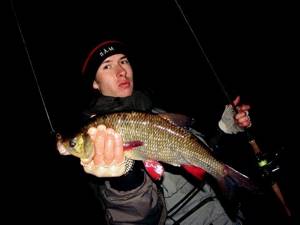
Spinners
Pinwheels are perhaps the most popular kernel baits. They were caught with them 20 years ago, and they are still caught now. And this indicates the great versatility of these baits.
When fishing for ide, there are situations when the fish can only be caught using a spinner - for example, the bait must be lowered to a given depth and this can only be done using a spinner with a heavy core or a forward sinker (jig-spinner).
The most commonly used sizes of spinners for catching ide are No. 0–2 (according to the Mepps classification, for example, Aglia No. 2 or Comet No. 1) or weighing from 5 to 10 g, if we talk about the popular Myran spinners (models Agat, Tony, etc.). P.).
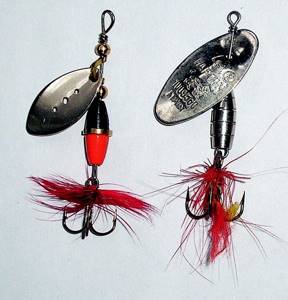
If we talk about compact heavy spinners (used for fishing at significant depths), then models with a heavy core (Mepps XD, etc.) have proven themselves well here.
We can’t help but touch on the topic of spinner hooks. Or rather their size. The ide has a small mouth, and not every tee of a large turntable will easily and simply fit there (although, of course, there are exceptions).
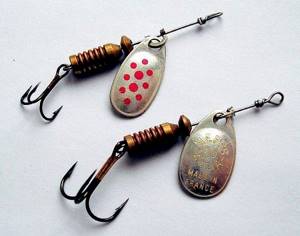
Therefore, it is better to replace large tees by placing 1-2 sizes smaller. Many fishermen believe that the edge or bright hairs on the tee of the spinner additionally stimulate the ulcer appetite.
Jig
On large rivers, jig baits (foam rubber, twisters) are most effective when catching ide in cold water, especially in early spring.
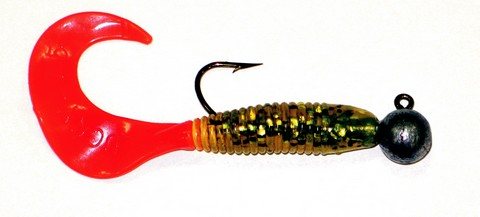
At this time, the ide lives at considerable depths (sometimes deeper than 6 m), preferring areas with a current and a hard bottom. The pitting jig is no different from the classic bottom step. The weight of the load is selected depending on the fishing conditions; the bait should hover for 1–2 seconds.

On small rivers, when catching roaches, small minnows (for example, Zip Baits Rigge 35 F), carried out with soft twitching or stop and go, have proven themselves well. Shallow-water cranks 3–5 cm long are also good.
Oscillating spoons
Spoon baits undoubtedly also deserve attention when fishing for ide. The small sizes (up to 10 g) of the famous Wob-L-Rite and Kastmaster spoons catch ide almost always and everywhere.
Sometimes ide is caught on Trekhgranka, especially when fishing in an asp pot, which is a typical phenomenon on the middle Volga. In general, there is a lot of ide in those parts, and often when catching asp it predominates in the catches over the latter.
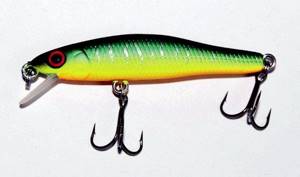
Wobblers
Today, wobblers are worthy competition for spinners in ide fishing. And this is due to the increasing passion of anglers for ultralight. Small wobblers 3–7 cm long, both sinking and floating, are successful.
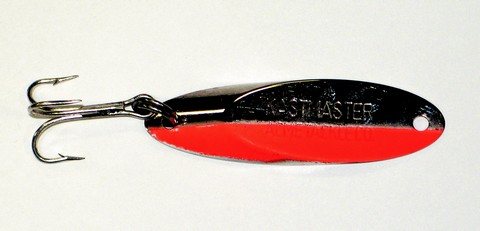
But if the ide is kept at a depth of 1.5–2 m (deep oxbow lakes, whirlpools), deep class wobblers, such as Pontoon21 Cheerful 40 SP or Duel Hardcor, will bring success
Choosing a place and time of fishing
Ide is an inhabitant of rivers with a gentle current and a clay bottom. In ponds and lakes it is not numerous and does not gather in schools, therefore catching it in such reservoirs is not advisable.
Favorite places for ide in rivers include:
- shallow holes below the rifts;
- deep dumps near spits and below islands;
- branches of bushes and trees hanging over the water;
- trees fallen into the water.
Read more
Spinning rod Major Craft: pros and cons
Often ides stand on straight sections of rivers with moderate depth in ribbon weeds inclined by the current. Also good places for fishing are areas behind bridge supports, piers, etc.
The ide feeds in the bottom layer or on the surface - collecting fallen insects, however, it often attacks spinners in the middle layers of water. Therefore, in a promising place it is worth fishing all the horizons.
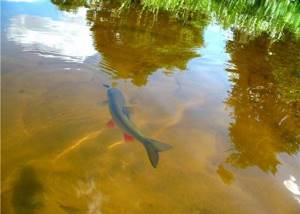
This fish rarely lives in areas with stagnant water.

